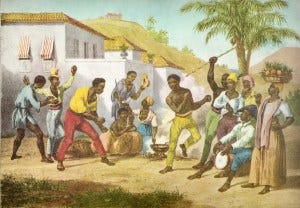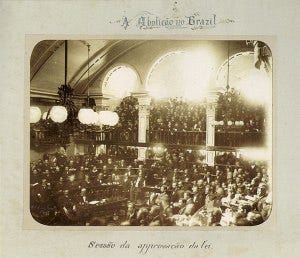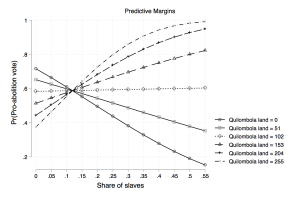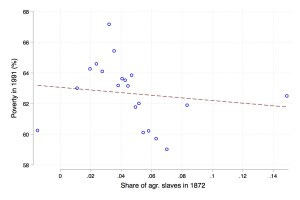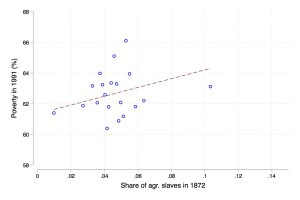Investigating the Political Economy of Slavery Abolition in Brazil
By François Seyler and Arthur Silve
The tale of the downfall of slavery in Brazil is that of a divided imperial aristocracy, of established latifundiários and frontier planters in direct competition with each other. It is a tale of entrenched economic interests slowing down social progress, and of how they eventually reconfigured themselves, consolidating into the coalition that declared extinct the last remnant of legal slavery in the Americas. And it is a tale of the agency of a people enslaved for generations, and how they contributed to ending one of the darkest facets of Western history.
International events and domestic reactions
In 1807, when Britain, the dominant power at the time, started to push – along with the United States – for the abolition of the Atlantic slave trade, slavery was an inherent part of the colonial economic system of Brazil. Brazil had been the largest destination of enslaved African individuals: the Trans-Atlantic and Intra-American slave trade databases document that over 5.5 million Africans were sold as slaves in Brazil between 1500 and 1850. The Empire of Brazil, founded in 1822, had little choice but to accept to ban the trade in 1831. At first, it did not act to enforce it, however, dependent as its plantations were upon the continuous supply of enslaved Africans. It took another 20 years for the Empire to enforce the ban. The Atlantic slave trade almost completely dried up in 1851. It was replaced by a domestic slave trade, by land or by boat, with a large shift from the Northeastern sugar-growing region to the Southeastern coffee plantations. Brazil would not bring in more enslaved Africans, but had no intention to improve the situation of those that were there already.
International pressure to abolish slavery did not abate in 1851, though. The Civil War in the United States, and the abolition of slavery there, isolated Brazil on the international scene. Domestically, newspapers and clubs advocating for abolition flourished. Nevertheless, the imperial institutions that had been designed to promote the interests of plantation owners and merchants made very few concessions to pressures both international and domestic. The most significant concession they made, in 1871, was to pass a law that would liberate children born of enslaved mothers once they reached adulthood. The Lei do Ventre Livre temporarily placated abolitionist sentiments, even though its effects would not be felt before two decades.
After 1884, in the three last legislatures before a military coup established the First Republic in 1889, Parliament voted on a dozen of bills related to slavery, until it finally settled the issue in 1888 and abolished it with the bill that became known as the Lei Áurea. During this time, emancipation movements radicalized, with frequent rebellions, scenes of violence, and flights from plantations.
The determinants of labor coercion
A common view is that abolition was made possible by a combination of diplomatic and social pressure – in other words, abolition was the result of humanistic sentiments and the exercise of political power, from the top down. There is one account of labor coercion consistent with this top-down view of institutional change: according to the “labor demand” effect, coercion is more likely to arise and persist in contexts where the land-to-labor ratio is high. This is based on the idea that landowners would be able to extract a surplus from scarce labor only if they establish a form of coercion (serfdom, slavery, bondage etc.). The suppliers of labor themselves, according to this hypothesis, play no role in the determination of the institutional arrangement.
But the enslaved population did play a role in bringing down the institution of slavery. The multiplication of evasions, of rebellions, and of retaliatory raids from maroons, imposed an important cost on landowners, and on the system that they were sustaining. According to the “outside option” effect, coercion is more likely to arise and persist in contexts where the land-to-labor ratio is low, as there is then little space for the coerced individuals to escape to.
Interestingly, the two effects are opposed. Scholars often know the labor demand effect as the “Nieboer-Domar” hypothesis, and associate the outside option effect with the neo-Malthusian study of the decline of coercive feudal arrangements in fourteenth- to sixteenth-century Western Europe (Acemoglu and Wolitzky, 2011). With opposed effects, an obvious question arises: which one is more important? Is the land-to-labor ratio associated with stronger, or weaker coercion of labor? Previous empirical works, looking at the empirical relationship, find support for the labor demand effect in Nigeria (Fenske, 2012), South Africa (Green, 2014), and in the Czech Republic (Klein & Ogilvie, 2017). This does not disprove the outside option effect, but it does establish the relative importance of the labor demand effect. The next question to ask then is: can we assess the relative importance of the two opposed mechanisms?
Outside options, labor supply, and legislators’ revealed preferences
So, we set out to look for the elusive outside option effect. Can we characterize the extent to which enslaved and maroon populations help bring down slavery? As a country with an open agricultural frontier, with half of the province of São Paulo still branded as terreno desconhecido, uncharted land, on historical maps, and where slavery played such a defining role in social relations, nineteenth-century Brazil was an ideal case study. Instead of the land-to-labor ratio, we looked more closely at the mechanisms themselves, in order to identify them separately. Our purpose was to find evidence related to both the labor demand and the outside option effects, such that they would not hide each other.
In the labor demand effect, what matters most is the availability of cheap labor. Exogenous variation in the availability of another form of cheap labor, such as European immigrants, often tied to the land by debt or official settlement arrangements, should result in a tighter or looser labor market. As a result, we would expect that in areas where more immigrants settled, there would also be less opposition from landowners to abolition. Plausibly, the local MP may choose to support abolition earlier in the process. Indeed, in the 1880s, provinces started attracting immigrants to increase the supply of cheap labor. Meanwhile, we have no reason to believe that the local presence of immigrants changed the opportunity, or the difficulties of evasion, rebellion, or raids associated with the outside option effect.
Similarly, the cost of enforcement is at the heart of the outside option effect, more so than the land-to-labor ratio. If evasions and rebellions are frequent, if raids from maroons impose large costs on plantations, landowners may find that the institution of slavery is a lot of energy to maintain. Were these costs enough to make the whole institution of slavery unprofitable? A weaker observation is enough to understand why some landowners may have preferred to abolish slavery. The costs of enforcement were not equally distributed between landowners. In places where runaways were more likely to make a successful escape, e.g. as a result of ruggedness or remoteness, and establish communities of maroons (quilombos), landowners faced higher costs, first to limit further escapes, and second to protect themselves and their plantations from raids. These made the corresponding plantations comparatively more costly to operate under the institution of slavery, somewhat bridging the gap in the profitability of slavery compared to alternative labor arrangements.
Slavery was a national institution. Abolition was a national decision, taken in the Câmara dos Deputados, the lower chamber of the Brazilian Parliament, and that applied countrywide. Yet there was variation in the willingness, in some instances the eagerness, with which the shift towards abolition occurred. The province of Ceará, in the Northeast, banned slavery in 1884, while eight of the nine legislators that voted against the Lei Áurea in 1888 came from electoral districts of the Rio de Janeiro province. To characterize differences in the willingness to support abolition, we collected individual voting decisions on the thirteen emancipation-related bills that went in front of the Câmara dos Deputados, some of them passing and others defeated, in the last three legislatures of the Empire, spanning from 1881 to 1889. The roll was called on each of these votes, because the issue of slavery had a high public profile by then. Thanks to this, we know exactly how each legislator voted on abolition and on related bills.
Reconciling previous theories
In a recent working paper (Seyler and Silve, 2021), we used the resulting data set to establish the empirical relevance of both the labor demand and the outside option effect.
We start by showing that the 1872 prevalence of slavery, as measured from the first nation-wide census of the Empire of Brazil (and the last point in time when we can observe slavery at a disaggregated level prior to emancipation), is positively and arguably causally associated with a legislator’s likelihood to vote against emancipation bills between 1884 and 1888. If we assume that a high prevalence of slavery in a district corresponds to a larger labor demand, this could be taken as supporting evidence for the labor demand effect. There is, however, a simple alternative explanation. Maybe landowners who relied most on slave labor had a larger vested interest in the coercive institution. More importantly, we show that immigrants in the district increased a legislator’s likelihood to vote in favor of emancipation bills. We analyze carefully the case for a causal interpretation and find it to be plausible. This is more pointed evidence in favor of the labor demand effect.
Finally, we show that more land held by quilombolas in a district’s municipalities is associated with a higher likelihood that the legislator votes in favor of emancipation bills. Conversely, we find that the emancipation vote is more likely in districts where quilombos are closer. All our measures of the proximity to freedom/cost of coercion support an outside option effect that is between a fifth and half of the size of the labor demand effect. To the extent that we can transpose these estimates in other contexts, this is consistent with previous studies finding evidence of the labor market effect, but not of the outside option effect.
Slavery and its legacies
In another recent paper, François Seyler (2021, forthcoming JHPE) exploits our data on legislators’ voting behavior to explore the long-term consequences of the reluctance or eagerness to abolish slavery in the 1880s.
Causally assessing the long-run impact of slavery in Brazil poses a serious identification challenge (overcome in creative ways by recent studies, e.g. Fujiwara et al. 2019 in a working paper focusing on inequality). Not only were enslaved individuals employed in the most productive regions – so that at first glance one might conclude that coercive institutions drive economic activity – but we also typically only observe the prevalence of slavery as an 1872 cross-section. This may mask important underlying dynamics. François leverages variation in the support of local elites to coercive institutions, measured as a function of legislators’ voting behavior, to add an intensive margin measure of the local importance of slavery to the common extensive margin measure, the share of enslaved individuals in 1872, focusing specifically on heterogeneity.
Based on Seyler and Silve (2021), nay votes on emancipation-related bills reflect political support for the continuation of slavery as well as local elites’ reliance on the labor of enslaved individuals. This stronger reliance on coercive institutions may have deep long-run consequences, which might remain hidden when slavery is solely measured as an 1872 snapshot: even though the growth of the enslaved population was greater in the province of São Paulo than in any other region during the years prior to emancipation, Paulista planters were also willing to use immigrant labor within the coffee-growing regions. Indeed, François finds that reluctance towards emancipation in the 1880s means that municipalities are more unequal and poorer today.
This article also shows evidence consistent with the existence of long-run effects on social capital. In municipalities with a historically high population of enslaved individuals and stronger political support for the continuation of coercive institutions, individuals exhibit significantly and quantitatively important lower levels of generalized trust. Individuals in these municipalities are also more likely to have weaker beliefs on corruption and democracy. Overall, the evidence is consistent with the intergenerational transmission of weaker norms of cooperation stemming from more entrenched beliefs on coercion and greater exposure to coercive institutions.




